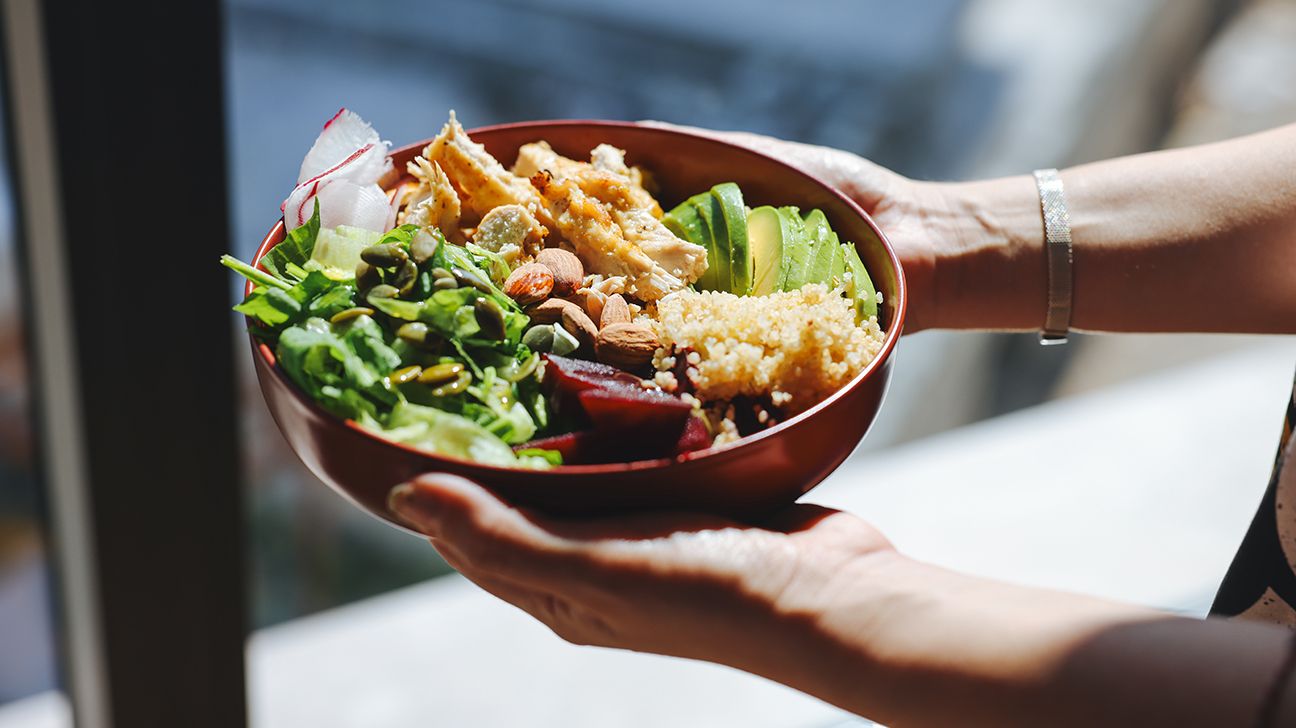There’s no specific recommended Mounjaro diet plan. A healthy diet with Mounjaro generally consists of fresh fruits and vegetables, whole grains, and lean proteins. Avoiding foods high in saturated fat, added sugars, and sodium is also vital.
Mounjaro (tirzepatide) is a GLP-1/GIP receptor agonist. It’s approved by the Food and Drug Administration (FDA) for use with diet and exercise to help manage blood sugar levels in people with type 2 diabetes.
Weight loss is an off-label use of Mounjaro. (Off-label use is when a drug is prescribed to treat a condition other than those it’s approved for.) Another tirzepatide product, called Zepbound, has been recently
If you’ve been prescribed Mounjaro for weight loss, you may be curious about what you should eat to maximize the drug’s effects. Keep reading to learn more.

It’s recommended that Mounjaro be used in combination with a healthy diet and exercise. But there’s no single set of guidelines for what you should eat while taking Mounjaro.
Every person taking Mounjaro is different. It’s important to work with your doctor to create an individualized dietary plan that addresses your specific dietary needs.
Generally speaking, sticking to a healthy, balanced diet can help you maximize the effects of Mounjaro. This means focusing on foods in the following groups, according to the
Vegetables
Vegetables may be fresh, frozen, or canned and include the following:
- leafy, dark green vegetables, such as spinach, broccoli, lettuce, and kale
- red and orange vegetables, such as carrots, sweet potatoes, and bell peppers
- legumes, such as beans, peas, and lentils
- starchy vegetables, such as potatoes and corn
- other vegetables, such as asparagus, Brussels sprouts, okra, and onions
If you’re taking Mounjaro for diabetes, consider focusing on non-starchy vegetables, as they have a lower carbohydrate content than other vegetable types.
Fruits
Fruits may be fresh, frozen, canned, or dried. This group also includes 100% fruit juice. At least half of your daily fruit intake should be whole fruit. Examples of common fruits include berries, apples, bananas, citrus, and peaches.
The American Diabetes Association notes that the best fruit choices for people with diabetes are those that are fresh, frozen, or canned with no added sugars. The organization also notes that most fruits, except for melons, pineapple, and some dried fruits, have a low glycemic index.
Grains
Other types of grains are refined and include items such as white rice, or are included in products such as white bread and pasta. It’s generally recommended that you limit your intake of refined grains.
Protein
Healthy protein sources include products such as:
Dairy
If you want to maximize the effects of Mounjaro, including weight loss, there are certain items you’ll want to avoid. These include:
- foods high in saturated or trans fats, such as:
- processed or cured meats
- butter
- full fat dairy products
- fried foods
- palm oil or coconut oil
- refined carbohydrates and products with added sugars, including:
- baked goods
- candy
- some fruit juices
- items that are high in salt
- alcohol
It’s also important to note that the most common side effects of Mounjaro affect the digestive system. These include nausea, vomiting, indigestion (upset stomach), diarrhea, and constipation. If you experience these side effects, it may be worth
- foods that are greasy, fatty, very sweet, or spicy
- caffeine
- alcohol
- high fiber foods (if you have diarrhea)
Do I need to avoid diet soda during Mounjaro treatment?
You don’t absolutely need to avoid diet soda with Mounjaro. But there are some reasons why you may want to consider limiting your intake, including the following:
- Higher diet soda intake has been
associatedTrusted Source with increased abdominal obesity. - Researchers have found that sucralose, an artificial sweetener in many diet sodas,
may increaseTrusted Source appetite. - Diet soda consumption has been associated with
diabetesTrusted Source andmetabolic syndromeTrusted Source . - It’s possible that artificial sweeteners
may worsenTrusted Source insulin resistance in people with type 2 diabetes.
This section contains answers to some of the more frequently asked questions about Mounjaro and weight loss.
Are there any tips and tricks to losing weight with Mounjaro?
In addition to a healthy, balanced diet, it’s important to make other healthy lifestyle changes to lose weight during treatment with Mounjaro. Some examples include:
- engaging in regular physical activity, ideally
at least 150 minutesTrusted Source of moderate intensity activity each week - staying hydrated
- getting enough good quality sleep each night
- finding ways to reduce your stress levels
Approximately how long will it take to lose 25 pounds (lb) with Mounjaro?
Weight loss varies by individual, but drug study results can give us a general idea.
For example, a 2022 study of tirzepatide (the active ingredient in Mounjaro) prescribed for obesity included people with an average weight of 231 lb. After 18 months, participants on the lowest dosage lost an average of 15% (about 35 lb) of their starting body weight. Those on the highest dosage lost an average of 20.9% (about 48 lb) of their starting weight.
How many daily calories should I eat with Mounjaro?
It’s important to talk with your doctor about how many daily calories you should eat during treatment with Mounjaro. In studies of Mounjaro, participants ate a diet with a deficit of 500 calories per day. (This means they ate 500 fewer calories than they burned each day.)
How much protein do I need to eat with Mounjaro?
Currently, the international
It’s best to focus on a healthy, balanced diet while taking Mounjaro. This includes a diet rich in fresh fruits and vegetables, whole grains, lean protein, and low fat dairy products.
To maximize the effects of Mounjaro, avoid foods that are high in saturated or trans fats, added sugars, and sodium. Individuals with diabetes may also want to avoid food items with a higher glycemic index.
It’s important to talk with your doctor about an appropriate diet plan when starting Mounjaro. They can work with you to recommend a plan that meets your individual dietary needs.
Disclaimer: Healthline has made every effort to make certain that all information is factually correct, comprehensive, and up to date. However, this article should not be used as a substitute for the knowledge and expertise of a licensed healthcare professional. You should always consult your doctor or another healthcare professional before taking any medication. The drug information contained herein is subject to change and is not intended to cover all possible uses, directions, precautions, warnings, drug interactions, allergic reactions, or adverse effects. The absence of warnings or other information for a given drug does not indicate that the drug or drug combination is safe, effective, or appropriate for all patients or all specific uses.






